Have you ever wondered how to make the color of a TFT screen more vibrant? Is there any technical solution that can enrich the display's color and provide a stunning visual experience? Quantum dots (QD) are a cutting-edge technology that significantly improves picture quality with exceptional color accuracy.
Quantum dots are like tiny colorful light bulbs. Through emitting different color light which could increase wider color gamut , presenting more vivid and realistic color, deliver an overall amazing viewing experience and display quality.
What Are Quantum Dots?
Quantum dots(QDs) are semiconductor material which is nanometer size. The emitting wavelength (color) can be finely tuned by precisely controlling the particle size of different materials. As below Figure 1, when quantum dots are emitting by blue light-emitting diodes (around 450 nm), it will emit pure single colors which are vivid red, green, and blue light. This increase in color purity allows our eyes to perceive more vibrant colors on the display.
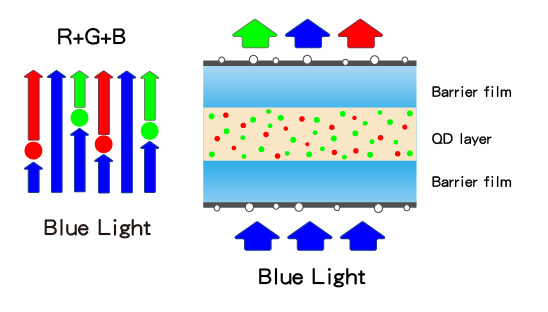
Figure 1
The size and composition of a quantum dot would directly influence the wavelength of the emitted light. Larger quantum dots size will emit red light with longer wavelength, while smaller ones emit blue light with a shorter wavelength. Using CdSe quantum dots for instance, partical size of 10 nm emit red light, 5 nm emit green light, and 2 nm emit blue light. Figure 2. Schematic diagram between Quantum dot partical size and emission wavelength.
Those quantum dots can be emitted light by (blue) light. This technology, when applied to displays, elevates the display’s output to a more luxurious level.
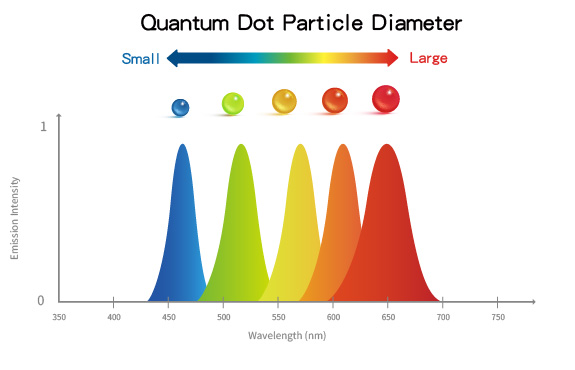
Figure2:Quantum Dot Particle Diameter
What is Color Gamut?
The term “Color Gamut” refers to the entire range of colors and tones that the human eye can perceive and that can be reproduced on an output device. A wider color gamut allows for a richer visual experience, enabling the display of more vibrant and diverse colors.
In the field of color science, the size of the color gamut is often represented as a triangle with a chromaticity diagram. The CIE 1931 color space, established by the International Commission on Illumination in 1931, serves as a foundational model for understanding color perception with a mathematical method. This model creates a “standard observer” that attempts to mimic how humans perceive different colors. Any color can be accurately located on the CIE 1931 xy chromaticity diagram, which provides a visual representation of color relationships.
To technically represent the range of the RGB colors, the color gamut is depicted as a triangle on an XYZ axis. The vertices of this triangle correspond to specific colors, and the area enclosed by these 3 points perfectly represents the capabilities of the color gamut (Figure 5). In the analog television industry, the NTSC (National Television System Committee) standard is commonly used to define and depict color reproduction capabilities.
TFT Display VS. Quantum Dots Display
TFT Display:
In the TFT display, the structure includes Backlight Unit (BLU) using a white LED which consists of the blue LED chip with YAG phosphors. This setup is designed to produce white light, which is filtered through color filters to create the desired red, green, and blue outputs. As shown in Figure 3.1, when the white light passes through a red filter, it is transformed into red light; similarly, green and blue filters operate in the same manner. However, one significant drawback of this conventional lighting solution is that the resulting colors may lack purity and vibrancy. As shown in Figure 3.2, because white LEDs emit light in a very board emission, the colors will interfere with each other.
Quantum Dots Display:
Quantum dot technology has revolutionized the display industry today, particularly through the use of Quantum Dot Film(QD Film). As shown in Figure 4.1, when applied to original structure of TFT LCDs, QD Film technology is integrated into the TFT module. This QD film is emitted by blue LED, resulting in the emission of highly saturated red and green light to mix with blue light backlight unit to white light. Then through the liquid crystal layer and color filter, a full-color display is achieved, which is called Quantum Dot Display.
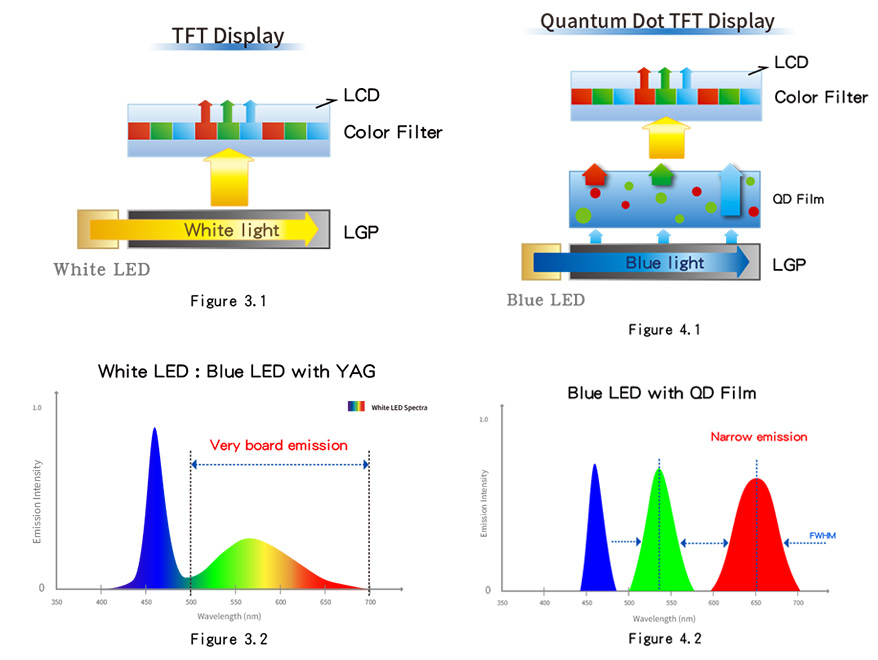
Advantages of Quantum dot displays:
Improved Color Results:
One of the key advantages of quantum dot displays is their ability to enhance color performance. As quantum dots are emitting by specific wavelength light, the Full Width at Half Maximum (FWHM) of their emission is narrow around 20~35nm (Figure 4.2). It can reduce the interference between colors, resulting in improved color accuracy and purity on the display. This brings the viewers with more vivid and true visual experience in life.
Wider Color Gamut:
The incorporation of quantum dots expands the color space of the display, allowing for a broader range of colors to be reproduced. This capability enables manufacturers to deliver more lifelike colors, matching the hues found in the nature.
In Summary, the application of quantum dot technology in TFT LCD structure significantly enhances color reproduction, resulting in richer, more vibrant displays. Quantum dots provide high purity and saturation of color while expanding the color space, allowing TFT displays deliver a more lifelike and accurate color experience for viewers.
Solution
Take the WINSTAR WF101N model as a case study, we can explore the impact of quantum dot technology on display color output by incorporating a quantum dot film.
According to the CIE 1931 xy chromaticity diagram as below Figure 5 and data table 1, the results indicate that the color gamut of the WF101N with the QD Film(represent by the gray line) exceeds that of standard TFT LCD and the NTSC color standard. Specifically, when using NTSC 100% (black line) as a reference, the NTSC value for the WF101N without the QD film is 74%, while the value with the QD film is rising to 111%(gray line). This finding clearly demonstrate that the quantum dot technology enhances the color gamut range, allowing for a richer and more vibrant reproduction.
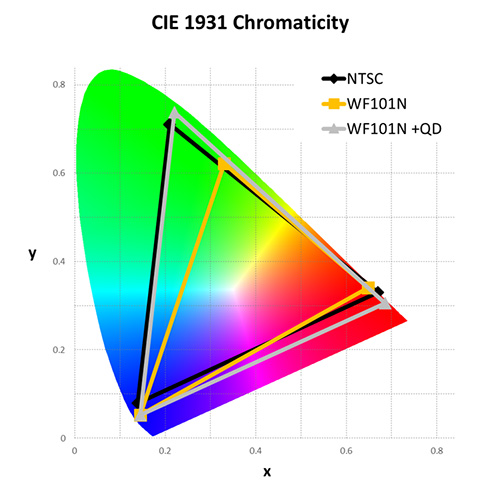
Figure 5. CIE1931
| Model |
Rx |
Ry |
Gx |
Gy |
Bx |
By |
NTSC% |
| NTSC |
0.67 |
0.33 |
0.21 |
0.71 |
0.14 |
0.08 |
100% |
| WF101N |
0.648 |
0.341 |
0.33 |
0.622 |
0.145 |
0.053 |
74% |
| WF101N +QD Film |
0.686 |
0.306 |
0.221 |
0.738 |
0.146 |
0.053 |
111% |
Table 1: CIE 1931 measured data
The visual comparison is as follows: On the left side features the standard TFT LCD, while the right side is the TFT LCD enhanced with a QD Film. It is evident that the QD Film equipped display provides bolder, more striking shades with higher saturation, resulting in a more lifelike viewing experience.
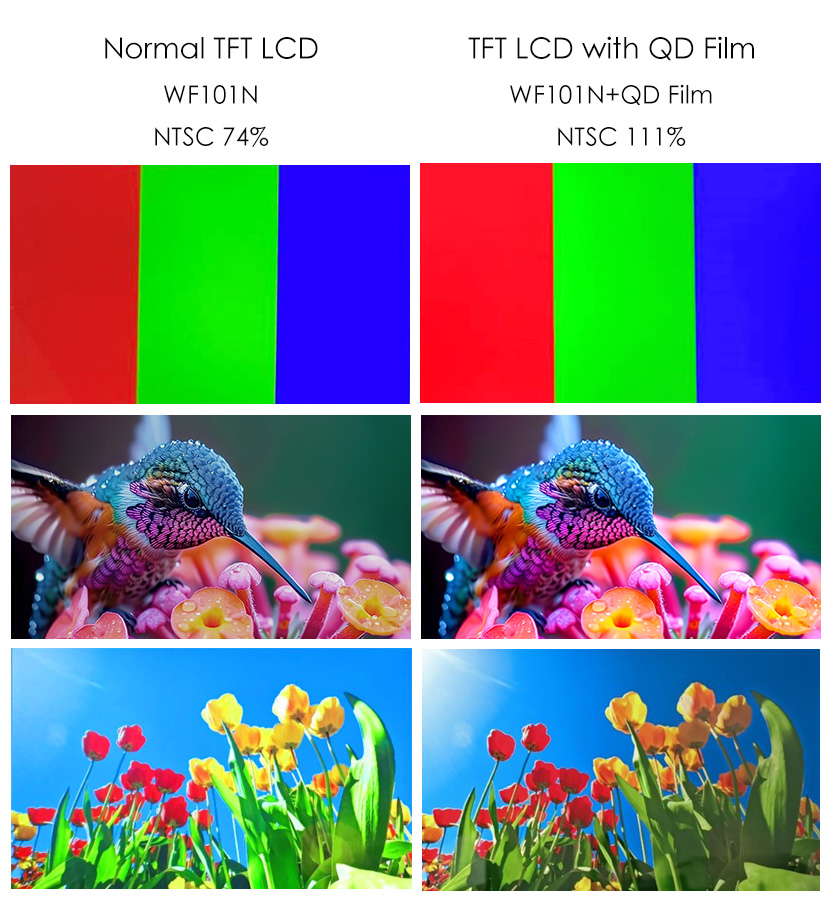
Figure 6
The application of quantum dot (QD) technology has significantly improved the color representation of WINSTAR’s TFT LCD display. This innovative technology enable the display to produce colors with higher purity and saturation while expanding the NTSC color gamut coverage. This leads to an increased color accuracy and a more realistic display on the screen. The Quantum dot displays not only deliver eye-catching and true-to-life colors but also set a new standard for visual experience, making them more appealing and engaging.










